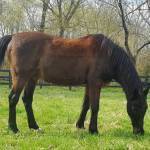Pinpoint PPID in Horses Earlier By Careful Observation, Diligent Diagnostics

Approximately one in five horses over the age of 15 years has PPID (pituitary pars intermedia dysfunction, previously referred to as equine Cushing’s disease), which has devastating consequences on health. Don’t wait for the telltale coat changes to test for the disease and devise a treatment plan. Instead, look for early changes in your horse’s health and be aggressive with diagnostic testing when PPID is suspected.
“Being able to recognize PPID early in the course of the disease process allows owners to initiate appropriate treatment prior to the development of severe clinical signs, including life-threatening laminitis,” said Peter Huntington, B.V.Sc., M.A.C.V.Sc., director of nutrition for Kentucky Equine Research Australia.
Unfortunately, diagnosing PPID early in the disease process is fraught with challenges. Other than generalized hair overgrowth, called hypertrichosis, there are no characteristic signs indicative of PPID.
“Other clinical signs of disease are mild and therefore often not observed by owners. Or, the signs can easily be confused with other diseases,” Huntington explained. Examples of these milder signs of PPID include:
- Regional hair overgrowth and postponed shedding;
- Recurrent infections;
- Delayed wound healing;
- Weight loss and loss of topline muscle;
- Disrupted thermoregulation;
- Lack of normal sweating or heat stress with exercise intolerance; and
- Reduced fertility.
Further, when specific laboratory testing for PPID is performed by a veterinarian, those results may be equivocal due to the imperfect nature of the tests and natural or seasonal fluctuations of hormone levels.
“The two most common tests used for diagnosing PPID are the ACTH test and the TRH stimulation test. In some cases, both may be required,” Huntington said.
Recognizing the importance of diagnosing PPID early, before hypertrichosis and laminitis occur, an Australian veterinary research team dove deeper into laboratory testing for PPID. They recruited seven horses with no clinical signs of PPID but equivocal ACTH test results. Those seven horses were subsequently followed for four years from October 2017 until November 2021. During that time, ACTH testing and TRH stimulation tests were sequentially performed and any clinical signs suggestive of PPID were recorded.
Those results showed that measuring basal ACTH levels is a simple first-line diagnostic in horses showing end-stage signs of disease, such as when general hypertrichosis is present. Researchers found no value in also performing the TRH stimulation test in such cases. In contrast, the TRH stimulation test “substantially increased accuracy of diagnosis” in horses in the earlier stages of the disease, according to the researchers.
“Considering how commonly PPID occurs in geriatric horses, aggressive testing and monitoring should be a part of the routine care of this patient population. Treating with pergolide, instituting appropriate feeding programs, and offering antioxidants such as vitamin E or coenzyme Q10 to support immune function are all warranted in horses testing positive or when disease is strongly suspected,” Huntington said.
He also noted that care should be taken when using pergolide in certain competition horses, as it is a controlled medication under some rules. Further, obese horses and ponies with PPID at risk of laminitis should be tested for insulin dysregulation as they may also have equine metabolic syndrome.
Information on PPID is also available from the Equine Endocrinology Group.**
*Kirkwood, N.C., K.J. Hughes, and A.J. Stewart. 2022. Prospective case series of clinical signs and adrenocorticotrophin (ACTH) concentrations in seven horses transitioning to pituitary pars intermedia dysfunction (PPID). Veterinary Science 9(10):572.
**Hart, K., A. Durham, N. Frank, C. McGowan, H. Schott, and A. Stewart. 2021. Recommendations for the diagnosis and treatment of pituitary pars intermedia dysfunction (PPID). Equine Endocrinology Group.








